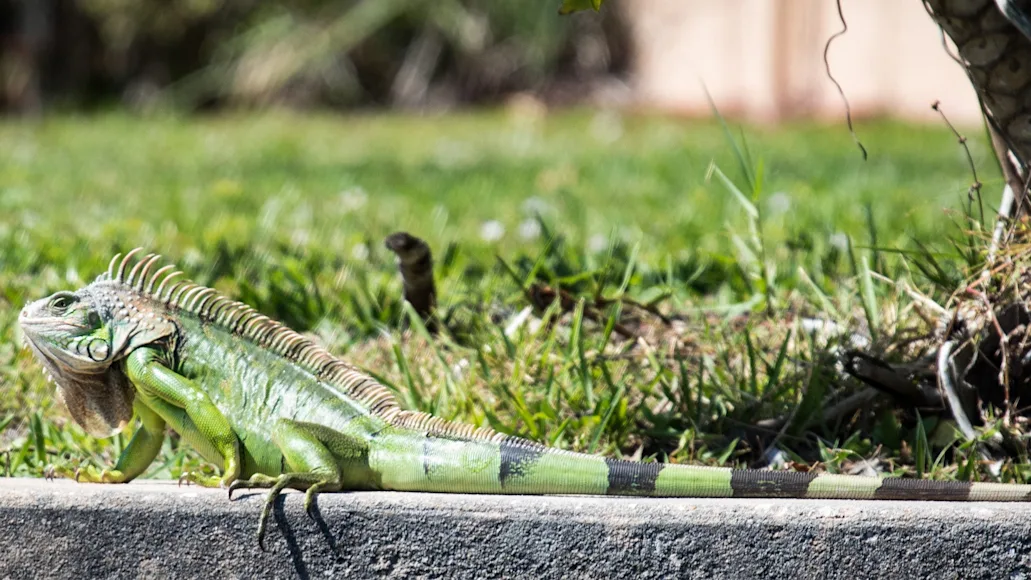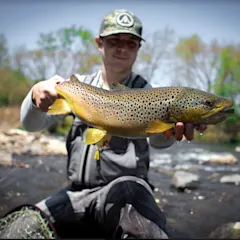The green iguana
is a staple of many tropical locations and, in more recent years, a common sight in the state of Florida. Since the 1960s, this invasive species has grown exponentially and established itself throughout the southern part of the Sunshine State. But these seemingly nonchalant oversized lizards are wreaking havoc on Florida’s ecosystems and infrastructure. After displacing native wildlife and causing millions of dollars in damage
, the Florida Fish and Wildlife Conservation Commission
gave the green light to hunters looking to help cull their numbers. That means a year-round season, no bag limits, fun shooting, and great eating. So whether you’re a permanent resident or on vacation, here’s everything you need to know for a successful Florida iguana hunting trip.
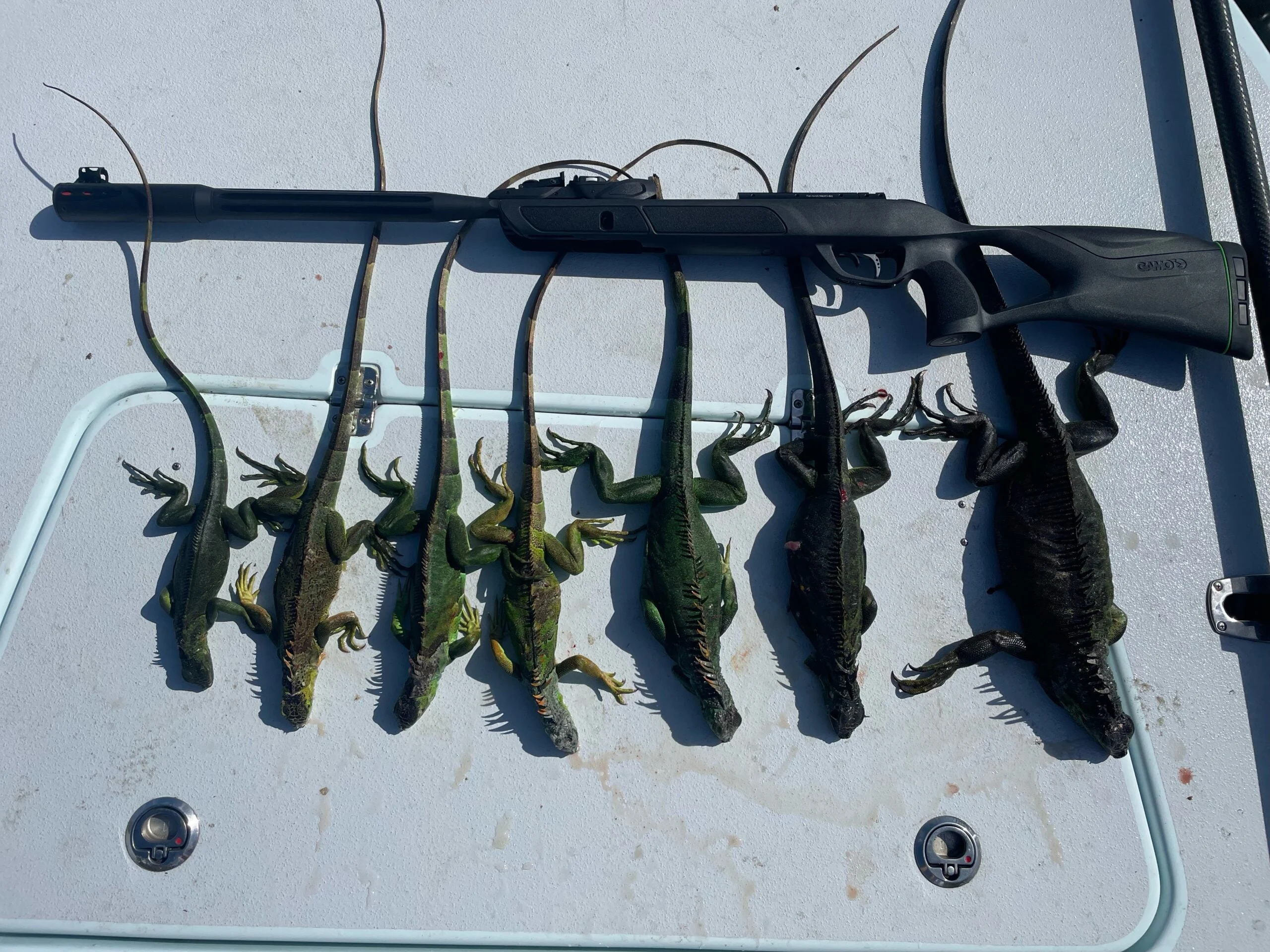
A hefty haul of green iguanas from an afternoon hunt. Max Inchausti
Florida Iguana Hunting: Locating & Identifying Lizards
Green iguanas are large lizards from the iguanid family. In Florida, there are three species of iguana: the green iguana, the Mexican spiny-tailed iguana, and the black spiny-tailed iguana. All green iguanas share several identifying characteristics that differentiate them from the other species. The easiest characteristic to look for is a barred tail. Green iguana bars are typically black in color but can vary slightly depending on the overall shade and pattern of the iguana. They also have a row of spikes leading from the base of the head to the tail. These spikes are prominent and easily distinguishable from other large lizards found in Florida, like monitors.
Male and female iguanas vary and are distinguishable by color and size. Female iguanas range from two to five feet long, with a majority in the three to four-foot range. Contrary to their name, not all green iguanas are green. They range green in color from bright green to muted shades of gray or brown in color. Males will range in size from two to nearly six feet in length. Smaller males will resemble females in terms of coloration. As they grow larger, males will display an orange or pinkish coloration. Both sexes also have a throat flap or dewlap. On males, this flap is noticeably larger to attract females and ward off predators.
History, Habitat, and Impacts
Like most critters in Florida, the green iguana is not native. In the 1960s, the first iguanas made their way to Florida, likely as hitchhikers on cargo ships. These first sightings were isolated to Dade County near Miami and Hialeah. Since their introduction, populations have exploded in size and distribution. They are now found throughout South Florida, extending their range
north of Lake Okeechobee. Any further north and winter cold snaps prevent them from establishing breeding populations. The highest densities exist along either coast, with smaller populations throughout central South Florida. Currently, South Florida and parts of South Texas are the only areas in the country with established iguana populations.
Iguanas are burrowing creatures, meaning they seek refuge in holes they dig. The mix of sandy soil and limestone offers these lizards ideal habitats to seek shelter. Look for rocky outcroppings, canal banks, and drainage pipes, and chances are you will find an iguana or two. They also thrive in urban settings
and are readily found in neighborhoods and city developments. During the day they will leave their burrows in search of food and sun. Like all reptiles, they are cold-blooded, meaning they use the environment to regulate their body temperature. As the air warms, iguanas will bask in the sun and warm themselves. When they aren’t sunning themselves, they are likely looking for food. They have a mixed diet consisting of fruit, vegetation, small insects, and eggs. They are also incredibly adept climbers, so be sure to look for them in trees, bushes, and even on roofs when Florida iguana hunting.
From a glance, these oversized lizards may seem harmless. Often meandering through grass and lazily lying in the sun, it’s easy to overlook the damage they cause to native wildlife. With a growing population, they pose a serious threat to native species. Both burrowing owls and gopher tortoises call the sandy banks of Florida home. Iguanas have encroached on their habitats, displacing them and competing for the same resources. In addition to ecological impacts, iguanas also have negative economic impacts. Throughout South Florida, Iguanas are responsible for millions of dollars in repairs along canal banks from burrows causing erosion. Palm Beach County recently spent $1.8 million on emergency dam repairs
, citing iguana burrows as the reason for the failing structure. With more and more lizards each year, managing the population is the only solution to minimizing these issues.
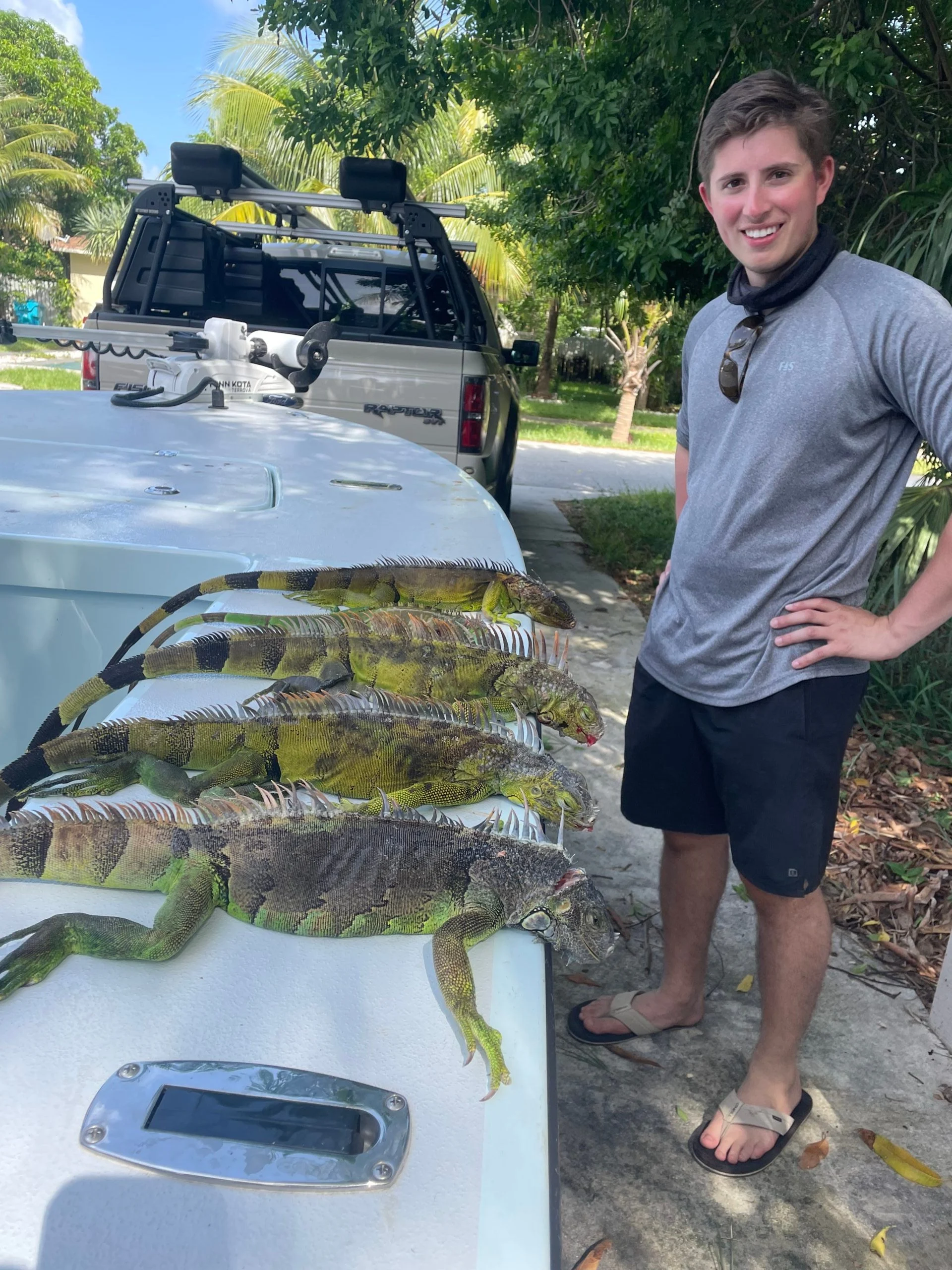
The author’s friend overlooks an impressive bag of large mature iguanas. Max Inchausti
Florida Iguana Hunting
In an effort to control iguana populations, Floridians are urged to do their part in culling their numbers. This means hunting. An abundance of lizards offers fast-paced shooting and a fun day for experienced and novice hunters alike. Here’s what you need to know before heading out in search of Florida’s unwelcomed invasives.
Tactics
There are two main ways to hunt iguanas: with air rifles
and with noose poles. Air rifle hunting is the most popular of the two. Hunters target habitats like canal berms either on foot or by boat. Hunting on foot offers a stealthy approach, especially with wary lizards who know that the sound of an outboard means trouble. Boat hunters usually have the advantage of covering a larger area, and I recommend this for the most success. To ethically dispatch an iguana, aim for the eye. This is the quickest way to stop an iguana in its tracks and avoid wounding them.
Modern pellet rifles in the .20 caliber to .30 caliber
range are the preferred tool for the job. They offer notable stopping power compared to beginner .17 caliber pellet rifles. While break-action models will do the job, pneumatic air guns allow for quick and consistent follow-up shots. They are surprisingly good swimmers and will often dive away after being hit. Serious iguana hunters
will go as far as having dedicated iguana dogs to make sure their bounty doesn’t get away.
Another option for Florida iguana hunting is noose poles. This technique requires a long pole with a rope and a sliding loop. Longer surf fishing rods with reels are often used as well. The concept is straightforward: sneak up on an unwitting iguana and snare them by the neck before retrieving your lizard. In actuality, it is much harder. Iguanas are fast and more alert than they look. Position yourself behind them, out of sight of their vision, and carefully sneak up. You might get busted the first few times, but it is a great exercise in stalking that translates well to other types of hunting. In Florida, it is illegal to transport live iguanas. If you snare them, be sure to dispatch them before heading home from the hunt.
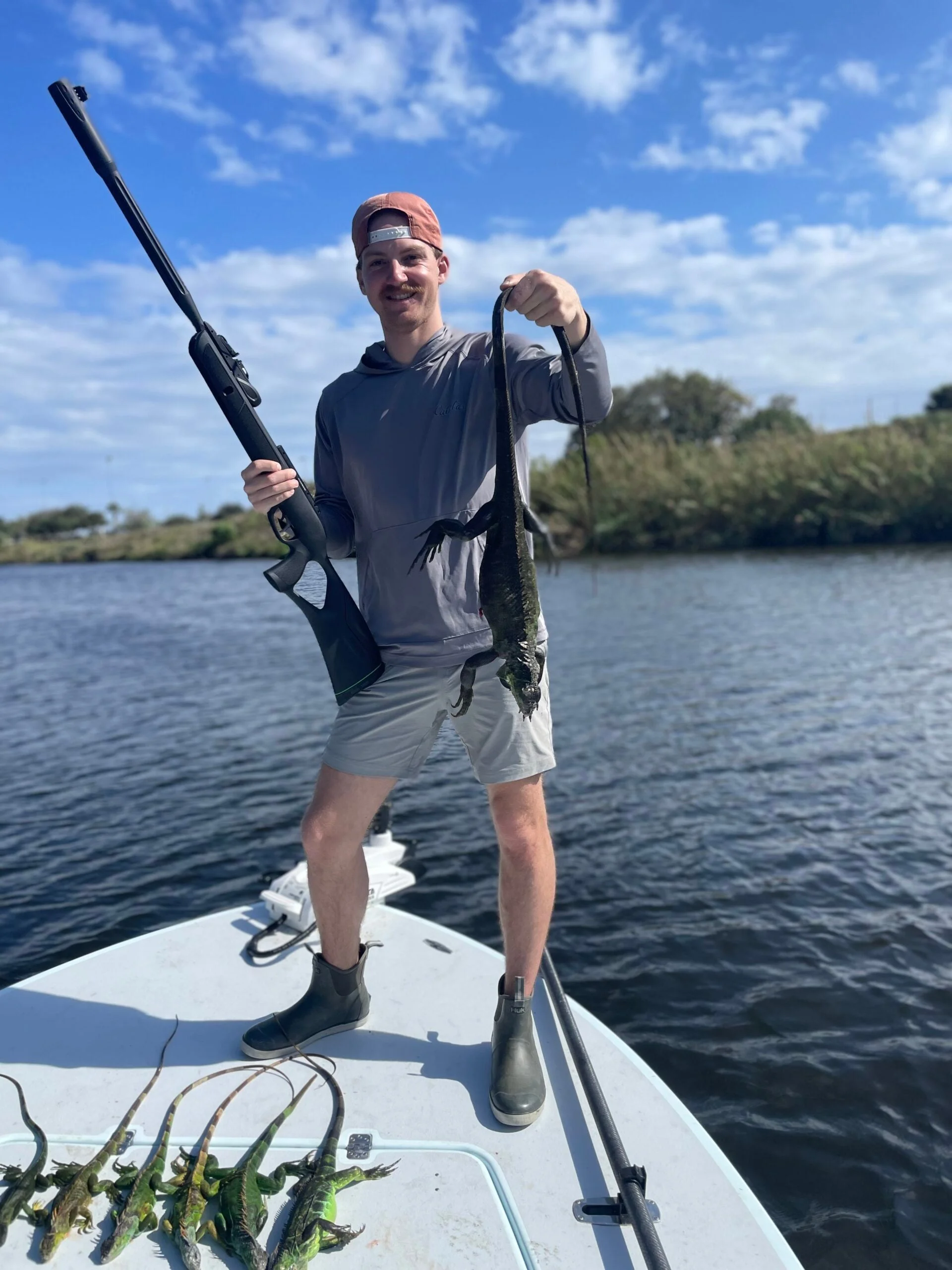
F&S editor Ryan Chelius holds up an iguana after a successful day on the water. Max Inchausti
Florida Iguana Hunting: Rules & Regulations
While iguanas are seemingly everywhere in South Florida, there are rules on where you can hunt them. If you own private property, these green lizards are fair game as long as you are harvesting them in a safe and ethical manner. They are invasive, meaning the only laws protecting them are anti-cruelty laws. For public land hunting, the Florida Fish and Wildlife Conservation Commission has designated 32 public lands
for year-round hunting. With abundant opportunities and no hunting license required, it is a great way to introduce new hunters to the sport.
Guides
If you’re visiting Florida and want to chase iguanas for the day, a guide is a great option. They make a living controlling iguana populations and putting customers on fast-paced hunts. The legendary Python Cowboy
has built a reputation as one of Florida’s best. Based in Palm Beach County, he has single-handedly put a dent in the population. It’s not uncommon to shoot upwards of 50 in a day. Mike knows the areas these lizards call home, and his dogs are eager to put on a show. There are several other exceptional guide services depending on where you are in Florida.

From top right clockwise: Cleaning an iguana tail, iguana tacos with pirogies, Ryan Chelius cleans an iguana after a successful hunt.
Cooking
Don’t be fooled: iguanas are exceptional table fare. The majority of the meat comes from their legs and tail. A good knife makes quick work of its tough skin, leaving you ready for the fryer. My preferred method of preparation is iguana tacos. Bread them and deep fry them until golden brown. Add them to a tortilla and dress with your toppings of choice for a delectable and exotic meal. And yes, they taste like chicken.

